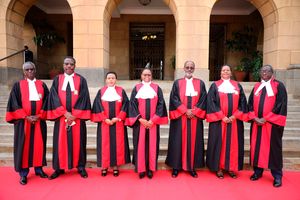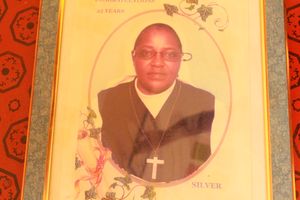Premium
‘Today in History’ tells the stories of our past through iconic images

A guest reads a ‘Daily Nation’ copy during the second edition of the SMEs Conference and Expo held at the Kenyatta International Convention Centre, Nairobi, in March.
MP beats up chief at Harambee rally.” That is the splash headline of the Daily Nation of March 27, 1989. “Today in History”, the storytelling feature of the new-look Nation, retold the story last Friday.
In the original story, the MP, Paul Chepkok, and the chief, Francis Kimuge, argue about the licensing of the meeting held in Elgeyo-Marakwet District (now county). Then Mr Chepkok pounces on the chief, sending him sprawling on the ground with an uppercut. The crowd watches in utter amazement and shock.
In the “Today in History”, readers expected a picture of Mr Chepkok assaulting Mr Kimuge. But instead of looking at a dare-devil pugilist, the readers are treated to a boring picture of Mr Chepkok, taken three years earlier at another fundraiser, holding a bundle of banknotes!
No photo
In another story published on Thursday last week, about the March 25, 1977 execution of the Republic of Congo’s former President Alphonse Massamba-Débat, “Today in History” has a picture of Tanzania’s President Julius Nyerere welcoming then-President Massamba-Débat in Dar es Salaam nine years earlier.
In both cases, however, the caption makes it clear that what is pictured is not the event that is being featured.
Daily Nation Opinion Editor Mwiti Marete says the Nation, unfortunately, did not have a photo of the actual event in each case. The photos used are, therefore, aimed at showing readers what the persons involved looked like. He wrote, in response to my enquiry: “We often don’t have the photo of the event being recalled and one from a different event is used in a bid to show the face of the subject.
“In that case, the first part of the caption explains the event as it happened and the latter one the occasion when the illustrative photo was taken.”
The purpose of “Today in History” , Mr Marete further explains, is to remind older readers, and inform the young ones, of events that happened on the particular date.
“Today in History” is an engaging, compelling and often delightful and amusing way of learning or re-learning our history.
Historical relevance
“Some people have seen some old photos of their parents in this column and come to buy them for their records,” says Anniel Njoka, the Nation librarian who compiles “Today in History” on weekdays. He added: “Readers who happen to have my number normally send me congratulations messages.”
All the same, “Today in History” has two main challenges. The first is historical relevance and significance. The second is accuracy. The grainy picture that appears in yesterday’s “Today in History”, of US President Gerald Ford fleeing from reporters over the American involvement in Indo-China war, is not a particularly good example of historical relevance and significance for our readers.
By contrast, the “Today in History” published on February 16, on Yugoslavia’s President Marshall Tito admiring an impala shot by his wife Broz in Maasai Mara Game Reserve, is a particularly good example. The caption says: “After he shot a three-tonne male rhino and a two-and-a-half-tonne buffalo, he bragged to Vice-President Daniel arap Moi: ‘I came, I saw, I conquered’.”
Wednesday’s “Today in History” carries a picture of seven Asian young men from Uganda who “were turned away by Britain on March 10, 1970 for not having entry permits after Uganda President Idi Amin Dada ordered Asians to leave Uganda with immediate effect.” The date is March 31, 1970.
Githaiga Kairu, who frequently spots such errors, easily picked the inaccuracy. “Idi Amin became president in 1971 after overthrowing [Dr Milton] Obote. The Asians were expelled in 1972; so, the photo must have been taken after 1970,” he said.
Despite the shortcomings, “Today in History” has the potential of becoming a popular story-telling feature — a must-read History 101.
The Public Editor is an independent news ombudsman who handles readers’ complaints on editorial matters including accuracy and journalistic standards. Email: [email protected]. Call or text 0721989264.





